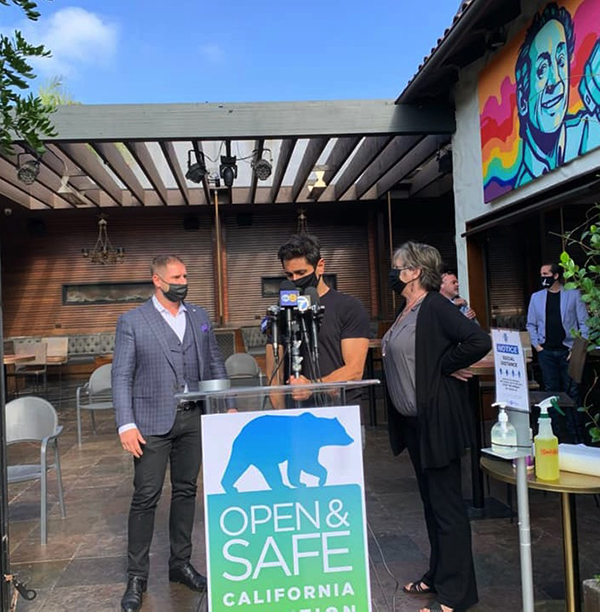Wave Wire Services
WEST HOLLYWOOD — City officials and local restaurant operators lashed out at the county’s decision to close restaurants to dine-in service Nov. 25, calling it a death knell for eateries and a failure of county leadership.
“The Board of Supervisors just laid off tens of thousands of people, including many West Hollywood residents, based on junk science and a need to make it look like they’re doing something,” West Hollywood City Councilman John D’Amico said at a news conference outside The Abbey on Robertson Boulevard. “All of this one month before Christmas. To that I say ‘bah humbug.’
“In fact, what they should be doing is opening up businesses for more hours, with strong operating regulations, careful code compliance efforts, smarter options for everyone — worker, resident, business owner alike. We don’t need to destroy this county to save it. We need to save it.”
The county has implemented a three-week ban on in-person dining amid a spike in local COVID-19 infections.
The ban prompted an emotional discussion during the Nov. 24 Board of Supervisors meeting, during which Supervisors Kathryn Barger and Janice Hahn introduced a motion seeking to un-do the restriction.
They argued the ban will be too onerous on restaurants that are already struggling during the pandemic, and said the restriction was being imposed with no evidence pointing to eateries as a major source of virus spread.
“We have even seen our positivity rate drop over the last four days,” Barger said. “Right now our positivity rate is the same as when we began to open Safer At Home. There is no sufficient data to show that outdoor dining has led to significant transmission. … No other county has taken the step to close outdoor dining.”
But Supervisors Sheila Kuehl, Mark Ridley-Thomas and Hilda Solis stood behind the ban.
Kuehl said dining out at restaurants — even on an outdoor patio — is the only allowable activity in which patrons interact without masks for extended periods of time.
“It’s a bit of magical thinking on everyone’s part to think that at any restaurant anywhere that the server keeps a six-foot distance from the table,” Kuehl said. “I sadly, but strongly, support moving our restaurants back to take-out and delivery.”
Standing in front of his restaurant, The Abbey owner David Cooley fought back tears as he looked ahead, fearing the three-week dining ban could stretch into New Year’s Day, which “will probably put me out of business.”
Cooley said he closed his business early in the pandemic but was able to reopen after making substantial investments in safety measures.
“We learned more about the virus and how to operate our business safely without contributing to its spread,” he said. “As the state and county constantly changed the safety protocols and regulations, we adopted to every one of them. And believe me it was extremely costly for small businesses to keep up with these guidelines.”
But now, he said, “all that investment is wasted.”
“These new closures place blame on the hospitality industry and small businesses,” he said. “We are good operators who go beyond the minimum guidelines to make sure our guests and our staff are safe.”
Genevieve Morrill, CEO of the West Hollywood Chamber of Commerce, noted comments from county officials who said 80% of restaurants in the county have been complying with safety regulations, saying the county should crack down on the other 20%.
“Our county and state government has abandoned us and we need your help,” Morrill said. “Our economy is now a public health issue as well. Your actions, government, are driving the unemployment. … Just checking the boxes off to show the public that you’re doing something is not enough.”
County health officials said during the Nov. 24 Board of Supervisors meeting that it agrees with targeted enforcement of restaurants, but there are 31,000 eateries in the county, and only enough inspectors available to visit about 1% of them a week.
Barger, who tried to stop the ban from taking effect, cited estimates by the Los Angeles Economic Development Corporation that approximately 700,000 food industry jobs could be lost, with 75% of those losses affecting workers earning $50,000 or less annually. She also suggested that major expansions in testing availability are also contributing to added case numbers.
County Public Health Director Barbara Ferrer did not directly refute that comment in the meeting, but noted earlier that the surge in cases is not just the result of increased testing. She said the county’s recent rise in positivity rates shows the virus is spreading more rapidly. The county’s seven-day average daily positivity rate among those tested for the virus was 3.9% on Nov. 1, but it rose to 5.1% by Nov. 8 and stood at 7.1% as of Nov. 21.
Barger suggested aligning with state guidelines and holding off on new mandates for two weeks to see the impact of earlier restrictions. But Ferrer said case counts would not decrease without further restrictions.
“We can’t really keep waiting to take action,” Ferrer said. “It’s not like without taking some additional steps we’re likely to see ourselves back to a more reasonable case number.”
Dr. Christina Ghaly, who runs the county hospital system, stressed that the current surge, if unchecked, could overwhelm hospitals.
“At this point, unless changes have been made in people’s behavior … to reduce transmission and unless steps continue to be made, then I do anticipate that we will use up those currently available beds,” Ghaly said.
“The problem … is not physical beds… The challenge, as it has been throughout the pandemic, is with staffing.”
Hospitals can shift some staff, but have no ability to draw on other regions for medical personnel given the nationwide surge in cases, Ghaly explained.













